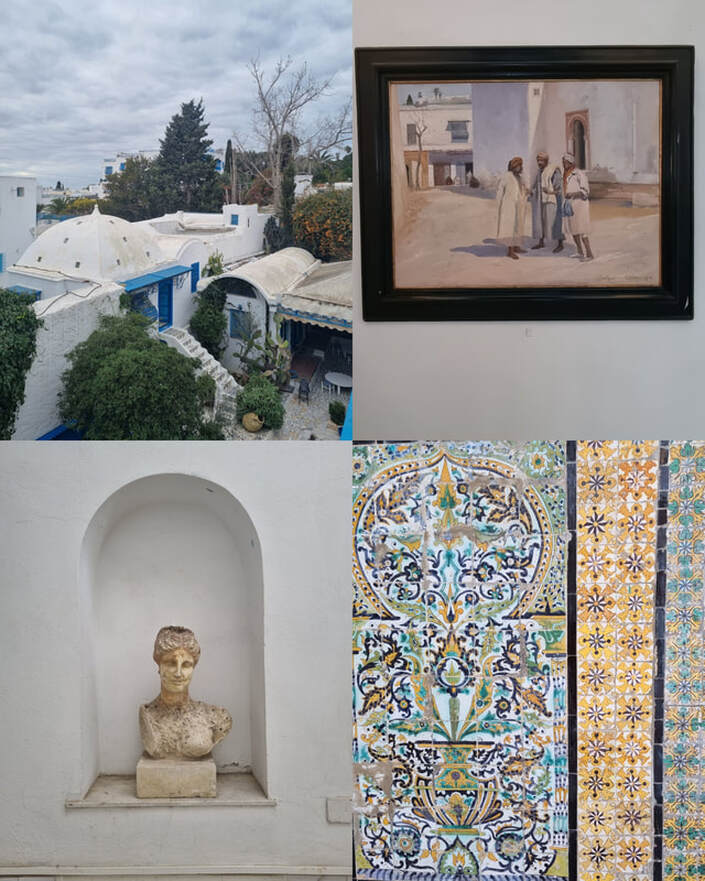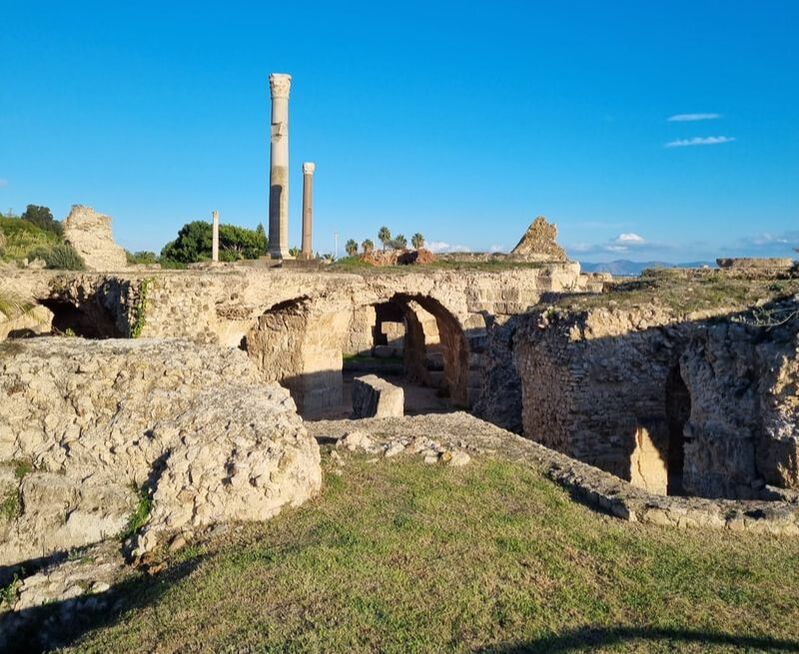|
Tunisia feels like an amalgamation of history, of a past riddled with intrusions and revolts. It is unmistakably North African, the whiff of spices and milky skin tones of locals reminding you that you’re somewhere very specific on the world map, on a continent far from home. There are buildings in the capital city of Tunis that would take you straight back to Paris, narrow with large windows and slim balconies lining the streets. The mosques and Arabic signboards tell you that somehow, some time ago, the Middle Easterners were here. And of course the Roman ruins, their marble sculptures of well-fed women and public baths indicating their presence here on Tunisian soil, however turbulent that may have been. The country itself is a pleasure to roam and explore, from cool lush highlands to barren deserts quenched with scattered oasis. We’ll get to that, but for now let’s take a good long walk around its capital city of Tunis, and the things one ought to see and do in this bustling Mediterranean melting pot of culture and history. The duration one should spend in Tunis to do it justice varies. You can do a couple of days focusing on the main sights, but you could also take a leisurely 3-4 days to really take your time exploring the city. Whichever your choice, here are some of the things you should see and do while you’re there. From Top Left, Clockwise: The Bab el Bhar, scenes inside the maze of Souks. Get Lost in the Souk, the Old Medina of Tunis In every big cities and towns of Tunisia, there will always be an old Medina. After all, it is how these centers began in the first place – a souk filled with shops, businesses and houses all clustered together forming a medieval community. In Tunis, you can begin your walk within the old medina from the Bab el Bhar, or the entrance of what used to be the old fort. These days, the walls have mostly disappeared, but this historical landmark is unmissable, sturdy and thick in front of a courtyard surrounded by old buildings and a fountain. From Bab el Bhar, there are obvious entrances into the Souk, a maze of narrow streets lined of with hundreds of shops, selling everything from clothes, street food, home items, spices, carpets, you name it. There are also old libraries, houses of rich merchants turned into tiny museums, mosques, and restaurants serving hot lunches. You can easily spend an entire day here if you wish. And while you’re at it, don’t forget to look out for the brightly-coloured doors of the Medina. Each different colours represent a owner’s status – yellow doors are the houses of commoners, blue doors are the rich, green doors are for the imaams or mosques, and red doors are spiritual establishments. Fish couscous at Fondouk el Attarine, a gorgeous lunch restaurant nestled within the labyrinth of the Old Town. Eat Couscous, the North African Staple Laden with Flavour If there is one meal you should eat in Tunisia, let that be fish couscous. Couscous is a staple in the country, tiny grains made from semolina flour that cooks to become this tender, fluffy goodness which carries other flavours really well. Enter the Tunisian fish stew, made with fresh fish poached in a lightly spiced gravy, then poured all over the said couscous. The result? A bowl of light yet comforting dish, fragranced with spices that are specifically Tunisian. In Tunis, I recommend three places to try this dish. Restaurant Sfax for a feel of budget-friendly, local establishment with rustic fish couscous, Fondouk el Attarine for a fancier location (with a fancier price tag) with linen tables and a beautiful courtyard within the old Souk, and Café Essaad in Sidi bou Said for an entire fish plopped on a a bed of couscous for your feasting. Of course, for my entire list of food I’d highly recommend you to try while in Tunisia, go here. From Top Left, Clockwise: The streets of Sidi bou Said, souvenir shops selling all sorts of local art, one of the many beautiful wooden doors along the streets, view from one of the many rooftop cafes to sit and people-watch. Santorini? No, but How About Sidi Bou Said If you Google Tunis, chances are the photos that would appear most on your screen would be of a blue-and-white seaside town, akin to those you find on the islands of Greece. Well this would be Sidi bou Said, an old seaside town used to be inhabited by artists and religious figures. On a sunny day it is extremely charming; think cobbled lanes, whitewashed buildings with blue shutters, doors and rooftops, bougainvillea creeping up the walls and tiny shops and cafes selling art and coffee. Spending a half day here is imperative, spending an entire day here is a breeze. The best way to enjoy this town is to simply park your car in the available areas outside the Old Town, and then take a long walk up and down the hilly streets. It is as quaint as it gets, although in peak seasons it gets quite touristy. Bamboulini stalls are available whether you're at the Souk of Old Town, or at Sidi bou Said. Eat a Sugary, Doughy Bamboulini Not something that I saw as much of outside Tunis, and so here’s something you ought to try while in the capital – bamboulinis. They are essentially fried dough covered with sugar, sold by the streets while still warm. But unlike your usual donut, the texture is a lot more airy and chewy, and makes for a great snack while walking around the city. Sold at a mere one dinar per very large piece, you should truly delight yourself with this guilty-yet-worth-it pleasure. From Top Left, Clockwise: View from the rooftop of Dar el Annabi museum, one of the beautiful art pieces in Ennejma Ezzahra Palace, Turkish tiles and Roman ruins at Dar ben Abdallah. Marvel The History Of Tunisia In Museums There are plenty of museums around Tunis. Some are mansions of rich merchants turned into a gallery of carpets and antique furniture. Some are old religious schools now serving as both an institution and a place to marvel Turkish marble work. Some are open courtyards of overlooking the sea, an exhibit of the lifestyles of important (and privileged) figures of the past. In central Tunis, a complex of buildings called Dar ben Abdallah preserves walls and indoor halls adorned with intricate marble work, traces of the Turks. It is free for everyone to come, and you can lazily walk around the indoor areas to admire them. In Sidi bou Said, the Ennejma Ezzahra Palace is a great example of aristocrat living back in the times, with a large mansion facing the Mediterranean, open to the public. One can spend a good amount of time gazing at the luxurious interiors and beautiful art preserved in the building. For a sweeping view of the white-and-blue town, a visit to the Dar El Annabi rooftops is a must. The Bath of Antoninus is a sprawling area of ruins by the sea, a delight to explore. Check Out the Roman Ruins of Carthage Carthage is an ancient capital city located outside of the Tunis city center. Approachable via train, bus, taxi or your own rented car, it boasts an extensive remain of the Romans, who sieged the civilization of Carthage around 146 BC. Perhaps not as well preserved as the ones in Europe of Jordan, it still makes for a wonderful day trip, as most of the ruins are located in strategic locations offering vast views of the landscape. You can easily get a package pass from one of the museum counters in Carthage that will allow you a day’s access to the main sites – the Baths of Antoninus is a recommended main choice. From Top Left, Clockwise: A variation of the Tunisian tea - with a medley of soaked nuts, A tea house in the Souk, another variation mint tea with almonds and pine nuts, hanging out at tea houses and cafes is a common pastime for locals, and you should join in. Enjoy the café culture of Tunis An influence of the French perhaps, but the café culture in Tunis is not to be missed. Along every main street and corner of city, you’ll find cafes dotted everywhere, offering French-influenced patisseries to the quintessential mint tea. Locals love to sit and enjoy their hot beverage especially on a chilly day, and you’ll notice some tea houses where the customers are mainly men, as is the custom of the Tunisians. After a long day of exploring, chilling at a café watching the sky turn dark and the city turn into a haze of light is a great way to end your adventure in the capital. |
Archives
May 2024
Categories
All
https:/
/www.bootsoverbooks.com/
|








